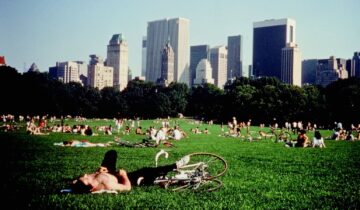George Nelson (1908-1986) was one of the most influential figures in American design during the second half of the twentieth century. With an architectural degree from Yale, he was not only active in the fields of architecture and design but also a widely respected writer and publicist, lecturer, curator, and a passionate photographer.
George Nelson: Architect, Writer, Designer, Teacher celebrated the birth of this iconic American designer, who would have turned 100 in 2008. Organized by the Vitra Design Museum to commemorate this occasion, the exhibition was the first comprehensive retrospective of Nelson’s work. It included over 120 three-dimensional objects, including examples of chairs, benches, desks, cabinets, lamps, and clocks as well as over 50 historical documents, including drawings, photographs, architectural models, and films. The exhibition was divided into five subject areas. Numerous furnishings by Nelson from the collection of the Vitra Design Museum—not only classics but also lesser known pieces—formed the core of the exhibition.
Nelson’s office produced numerous furnishings and interior designs that became modern classics, including the Coconut Chair (1956), the Marshmallow Sofa (1956), the Ball Clock (1947) and the Bubble Lamps (1952 onwards). As design director at Herman Miller, a leading US manufacturer of modern furniture design, Nelson had a major influence on the product line and public image of the company for over two decades. He played an essential role in bringing the company together with designers such as Charles Eames, Alexander Girard, and Isamu Noguchi. Early on, Nelson was convinced that design should be an integral part of a company’s philosophy, and by promoting this viewpoint, he also became a pioneer in the areas of business communication and corporate design.
Exhibition Sections
The first section, Nelson and the House, highlighted George Nelson as a pioneering planner and designer of the modern single family home during the 1940s and ’50s. Key items included architectural photographs of one of his first townhouse designs, the Sherman Fairchild House (New York, 1941); his bestselling book on modern housing, Tomorrow’s House (1944); and photographs and a model of his modular, prefabricated Experimental House (1952-57). Additional objects on view were images of his famous Storage Wall (1944) and original furniture pieces, such as the Herman Miller Case Goods (1946), Comprehensive Storage System (1959), Coconut Chair (1956), and Marshmallow Sofa (1956).
The extraordinary diversity of design tasks taken on by Nelson extended beyond furniture design. The Corporate Design section showcased Nelson’s numerous clients, Abbott, Alcoa, BP, Ford, Gulf, IBM, General Electric, Monsanto and Olivetti, as well as the United States government. Through brochures, advertisements, and vintage audiotapes, visitors explored Nelson’s success in developing corporate design at Herman Miller. He established his own firm, George Nelson & Company, in 1947 and ran it for more than three decades. Along with exhibitions, restaurant interiors, and showrooms, George Nelson & Company designed kitchens, flatware and dishes, record players and speakers, birdhouses and weathervanes, computers and typewriters, company logos and packaging, rugs and tiles.
Nelson was also a prominent innovator in the development of the modern office environment. Several of his functional designs were seen in the section devoted to The Office. Iconic examples included the L-shaped desk (1947), which was a forerunner of the workstation; Action Office (1964); and Nelson Workspaces (1977).
The exhibit design section focused on Nelson’s role as head designer of the American National Exhibition in Moscow (1959). The Chrysler Pavilion at the 1964-65 New York World’s Fair and Nelson’s exhibition work for The United States Information Agency were also highlighted.
The final section provided an overview of George Nelson as an author, editor, and one of the most important thinkers and visionaries in the realm of twentieth-century design. In addition to showcasing the numerous articles and books published by Nelson, this section showed some of his films and slide presentations, in which he addressed the topics of urban planning, consumerism, and aesthetic perception in Western society. Nelson’s analytical eye, his ability to go beyond mere questions of form and to think in the larger context of practical applications, and his achievements in the area of design education make his work—today more than ever—significant and highly relevant.
An exhibition of the Vitra Design Museum, Weil am Rhein, Germany. This Exhibition has been generously sponsored by Herman Miller.
Educational Materials
George Nelson Resource Guide
George Nelson Family Guide
Exhibition Sponsor
Oklahoma Humanities Council









